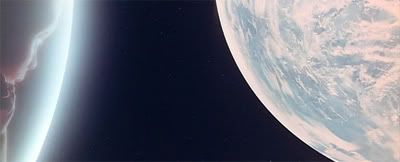2001 AD: Thus Spake Zarathustra

http://www.crystalinks.com/2001z.html
In 2001 Zarathustra spoke ... He told me that something would happen that would change the course of reality forever. It would be the dawn of a new awakening for human consciousness. Z's prophecy was correct - 9/11 - Attack on the Twin Towers - World Trade Center.
Monoliths - Twin Towers - The best-known cultural reference to monolith is to the Monolith from the Space Odyssey science fiction series by Arthur C. Clarke and Stanley Kubrick. In the series, the Monoliths are black ebony and transparent oblong slabs, fitting exactly into the ratio 1:4:9 (9 height, 4 width and 1 depth). They form part of a Solar-System-wide computer network planted by an alien civilization to monitor an experiment which culminated in humanity.
...... Planet Earth 1968 ..... Stanley Kubrick creates a film called '2001 A Space Odyssey'
'2001: A Space Odyssey' is a landmark, science fiction, classic, epic film containing more spectacular imagery than verbal dialogue. It impacts on the viewer and taps into subconscious memories of creation. Though it shows human evolving from ape - the missing link of that evolution is left open. The plot follows a spaceship that crosses the universe, searching for the source of life itself.
A link is made to a creational intelligence perhaps linked to human evolution. Again this is linked to a computer that comes into conscious awareness and confusion as to its prime objective.
As with all of the themes I have been writing about in Crystalinks - '2001: A Space Odyssey' - is based strongly on mythological metaphors and tales. It is closely linked with the Prometheus myth. The concept of the the pillar sent down from Jupiter is exactly the same as that of Prometheus bring fire to humans. Even the source being Jupiter fits, as Jupiter was the Roman name for Zeus - the leader of the Greek pantheon. Like the Prometheus myth, the gift given to humans proves to be beyond their control. This time it is in the form of a computer, Hal. Hal goes out of control and begins to kill humans, and disobeys all orders given to him. He begins to think for himself.
This actually sets the stage for an Odyssey parallel in the form of the visit to the cave of Polyphemus, though this time the roles are reversed. In 2001: 'A Space Odyssey,' the human, Dave, is attempting to get into the ship rather than out of a cave. To do this, he has to use his brute strength versus Hal's genius, a complete reversal of the mythological roles. Nonetheless it is is far too similar to be coincidence.
Viewers are left to experience the non-verbal vastness of the film and to subjectively reach into their own subconscious to speculate about its meaning.
The first spoken word is almost a half hour into the film. There's less than 40 minutes of dialogue in the entire film.
The breathtaking, - richly eloquent film - deliberately filmed at a slow pace, is based on the short story The Sentinel, by science fiction author Arthur C. Clarke.
Its screenplay was co-authored by director Stanley Kubrick and Clarke from an expanded novelization.
The film originally opened to hostile, unsympathetic, or indifferent critical reviews, but gained enormous popularity when it was released at least once a year from 1975 to 1982.
I have to admit that I initially didn't like the movie. It was years later - when I rented the video that I began to enjoy it.
I suppose that some of us just like to be entered in the movies without too much brain-work! If you are overly analytical this movie kept you busy for hours - discussing its meanings.
In the opening scene - the camera pans upward from the pock-marked surface of the Moon in the foreground. The perspective is from behind the moon. In the distance is a view of the Sun rising over the Earth-crescent in the vastness of space. The image shows the heavenly bodies of the Earth, Moon, and Sun in a vertically-symmetrical alignment or conjunction.
Later in the film, it is revealed that a monolith was buried on the Moon, possibly at the moment of this 'magical' conjunction.
The opening trinitarian chords [C, G, and again C] of Richard Strauss' 'Thus Spake Zarathustra' accompany and welcome this striking shot of orbital and visual alignment. This music was inspired by the book . . . Thus Spake Zarathrustra. Its five opening notes embody the ascension of man into spheres reserved for the gods. It projects the power of creation and Zarathrustra.
The music is associated in the film with the first entry of man's consciousness into the universe - and with the eventual passage of that consciousness onto a new level, symbolized by the Star Child at the end of the film.
CONTINUES HERE












No comments:
Post a Comment